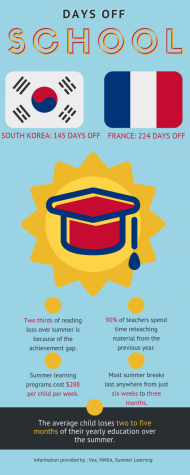Give me a break
Analyzing the placement of summer vacation
May 17, 2019
I’m in fourth grade. The afternoons reach 100 degrees and it’s gotten to the point where it’s so warm that I can’t sleep properly. At exactly seven in the morning, I wake up groggy and unaware, halfheartedly throwing on shorts and a T-shirt. Stumbling down the stairs, I look outside the window by my front door. I know in a couple hours, before it turns blazing hot, my neighbors will be playing pickup basketball outside, getting physical and going up for shots until their palms are as black as the pavement underneath their feet. I’m still looking outside my window for another ten minutes before my mom hastily hands me a bagel and an apple before telling me to get going. I lace up my shoes, check my bag one last time, then get in the car and head off to school.
In the middle of June.
When I was young, I attended a nearly year-round elementary school. We’d start school as soon as the calendar turned to August and got out when most kids were already halfway through their summer. And needless to say, I hated it. It sucked in the last month of the school year when I knew everyone was off from school and I still had to go through the same boring routine every day. School dragged out for so long that by mid-May mind would already be way out of school like all the other kids that ran on the “regular” schedule. However, my fourth grade self forgot about the middle of the year.
I don’t blame myself for not realizing this: back then, I was young and naive. I could never comprehend the idea that every day of the school year has to be spent somewhere. For some schools, they backload days into an eight to 10 week summer. What I didn’t realize was that the way my school oriented our days off was much different than the rest of the local schools. We’d get an extra week off in April while also getting two full weeks off in the middle of October. I never really noticed why the Disneyland lines were shorter than people would always complain about. I thought everyone had the same breaks as me.
As I got older, I slowly came to realize how much a short summer actually affected me. Every year since elementary school, all my summers lasted eight weeks or longer. And while I certainly did have more free time early in June to hang out with my friends and go on vacations, early August was still the same boring dreadful weeks it had always been. I’d lie down on my bed throwing foam balls at the roof above my head for what seemed to be countless hours, watching the clock tick by. Nothing had changed. The more dire consequences came once I returned to school. All my previous background knowledge somehow flew out the window. My prerequisite courses? Gone. Memorized bell schedule? Gone. Concept of waking up at six, running my morning on a timer? Gone. It began to take me one or two weeks to get back into the basic school routine. Coming into this school year, I remember looking back on my elementary school years and realizing this never happened back then. With only five to six weeks off, I never had this sort of problem— I’d still remember everything from the previous year. And it still felt good back then to walk out of school in early October knowing I could rest for another two weeks.
This entire concept, this enigma of where to put the days in a break, was just something I couldn’t comprehend. I couldn’t adapt well enough to the style at which my school year took a rest. At this point, I think I would rather have a school year where I could still remember all the knowledge I had from last year while still also getting a well-deserved rest. And while it could be argued that dragging out the school year will just make performance worse, theoretically, by mid-June, I think that it also extends possible opportunities to combine a rigorous academic schedule with a little extra breathing room.
We all need a break from school anyways. It’s simply a matter of where all those breaks are located. Whether they’re placed in between one month sections or loaded to the point where there is a break three months long, the ultimate goal is to get students to come back a little more refreshed. Students get to wake up late, stay in bed if they want to and go about their day knowing there are no homework assignments, no projects and no tests. Students would get more opportunities to do this if breaks happened more consistently throughout the year.
Personally, I’d rather have a system where I can put my pencils and paper away a couple more times, even if it means my hands will be sore from writing until it’s almost July.




























